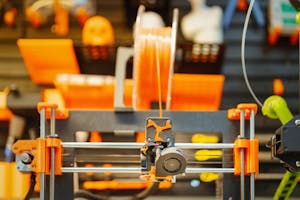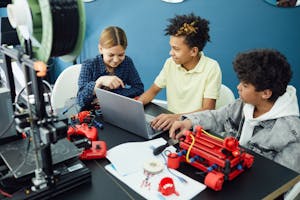In today’s rapidly evolving educational landscape, the integration of technology has become a pivotal aspect of teaching and learning. One of the most exciting innovations in this regard is the use of 3D models. These dynamic and immersive representations of objects and concepts have found their way into classrooms, transforming the way students engage with content and educators deliver it. So, here are a few things you need to know about ways in which 3D models are revolutionizing education. From enhancing comprehension to stimulating curiosity, their impact is far-reaching and multifaceted, influencing educational practices worldwide.
Enhanced Understanding of Complex Concepts
 The first and foremost benefit of 3D models in education is their ability to facilitate a deeper understanding of complex concepts. Traditional 2D diagrams or verbal explanations can often fall short when it comes to conveying intricate, three-dimensional structures. With 3D models, students can manipulate and explore these objects, gaining insights that are otherwise challenging to grasp. Whether it’s biology, chemistry, or engineering, 3D models make abstract ideas concrete, providing students with a solid foundation on which to build their knowledge.
The first and foremost benefit of 3D models in education is their ability to facilitate a deeper understanding of complex concepts. Traditional 2D diagrams or verbal explanations can often fall short when it comes to conveying intricate, three-dimensional structures. With 3D models, students can manipulate and explore these objects, gaining insights that are otherwise challenging to grasp. Whether it’s biology, chemistry, or engineering, 3D models make abstract ideas concrete, providing students with a solid foundation on which to build their knowledge.
Effective Science and Medical Education
The impact of 3D models is especially profound in the fields of science and medicine. Students studying biology can examine intricate cellular structures in unprecedented detail, while medical students can dissect virtual organs to understand their functions and anomalies. Such immersive experiences can enhance the knowledge and skills of future scientists and healthcare professionals, ultimately leading to more competent and confident practitioners in these critical fields of study.
Bridging the Gap Between Theory and Practice
One of the perennial challenges in education is the gap between theoretical knowledge and practical application. 3D models play a vital role in bridging this divide. By simulating real-world scenarios, they prepare students for practical challenges they might encounter in their future careers. This approach not only equips students with essential skills but also boosts their confidence, ensuring that they are not only well-versed in theory but also capable of applying that knowledge effectively in real-world situations, thus fostering a highly skilled and job-ready workforce.
Customized Learning and Accessibility
 Every student learns differently, and 3D models enable educators to cater to individual needs. They can be adapted to suit various learning styles, making education more inclusive. Additionally, they can be a game-changer for students with disabilities, as tactile learning aids can make complex subjects more accessible, promoting a diverse and equitable learning environment that caters to the unique needs of each learner, breaking down traditional barriers, and fostering a sense of belonging for all.
Every student learns differently, and 3D models enable educators to cater to individual needs. They can be adapted to suit various learning styles, making education more inclusive. Additionally, they can be a game-changer for students with disabilities, as tactile learning aids can make complex subjects more accessible, promoting a diverse and equitable learning environment that caters to the unique needs of each learner, breaking down traditional barriers, and fostering a sense of belonging for all.
Engagement and Active Learning
Engaging students in the learning process is a perennial challenge for educators. 3D models like the ones from DBM Vircon provide a powerful solution by turning passive listening into active exploration. When students can rotate, dissect, and interact with virtual 3D models, they become active participants in their learning journey. This hands-on experience not only captures their attention but also nurtures a curiosity that drives deeper learning, fostering a sense of ownership over their education and inspiring a lifelong love of learning.
Virtual Field Trips
Field trips have always been a cherished part of the educational experience, but logistical constraints often limit their frequency. 3D models have the potential to change that. Students can embark on virtual field trips to explore historical sites, visit far-off ecosystems, or even travel through time to ancient civilizations. These immersive experiences bring the world to the classroom, broadening students’ horizons, offering students an unprecedented opportunity to explore the world’s wonders, no matter their geographical location, and instilling a sense of global awareness and cultural appreciation.
Cost-Effective and Eco-Friendly
 Traditional teaching aids, such as physical models or specimens, can be expensive to procure and maintain. 3D models offer a cost-effective alternative. Once created, they can be used repeatedly without degradation, reducing the overall cost of educational materials. Moreover, they are eco-friendly, as they eliminate the need for physical materials, contributing to a more sustainable learning environment. This not only stretches educational budgets further but also aligns with the principles of environmental sustainability, instilling in students a sense of responsibility towards the planet.
Traditional teaching aids, such as physical models or specimens, can be expensive to procure and maintain. 3D models offer a cost-effective alternative. Once created, they can be used repeatedly without degradation, reducing the overall cost of educational materials. Moreover, they are eco-friendly, as they eliminate the need for physical materials, contributing to a more sustainable learning environment. This not only stretches educational budgets further but also aligns with the principles of environmental sustainability, instilling in students a sense of responsibility towards the planet.
3D models are ushering in a new era of education. They enhance understanding, engage students, bridge the gap between theory and practice, and make learning accessible to a wider audience, promoting a richer, more inclusive, and effective educational experience. Whether in the realm of science, history, or any other subject, 3D models are empowering both educators and students alike, reshaping the educational landscape for the better.